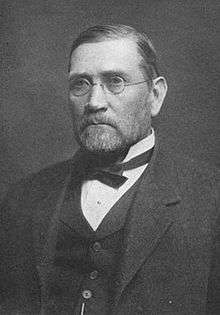George Lauder (Scottish industrialist)
| George Lauder | |
|---|---|
 | |
| Born |
November 11th, 1837 Dunfermline, Fife, Scotland |
| Died |
August 24th, 1924 Greenwich, Connecticut, United States |
| Resting place | Putnam Cemetery |
| Nationality | Scottish |
| Other names | Dod |
| Alma mater | University of Glasgow |
| Occupation | Mechanical Engineering, Business magnate |
| Employer | Carnegie Steel Corporation |
| Spouse(s) | Anna Maria Romeyn Varick |
| Children | George Lauder, Jr, Harriet Lauder Greenway, Elizabeth Storm Lauder |
| Parent(s) | George Lauder, Sr. & Seaton Morrison |
| Relatives | Andrew Carnegie |
George Lauder (November 11, 1837 - August 24, 1924) was a Scottish industrialist. A trained engineer, he was the "cousin-brother" of steel magnate and philanthropist Andrew Carnegie, and a partner [1] in the Carnegie Steel Corporation, a forerunner of U.S. Steel.
Early Years
George Lauder was the son of George Lauder, Sr. and Seaton Morrison. His father, a local shop owner on the high street, also known for his commitment to Scottish nationalism, egalitarian democracy, and the Chartism cause. He was a keen radical for the time, championing the preservation of human and public rights. Very well read, Lauder Sr. was instrumental in the upbringing of his only son George, as well as his nephew Andrew Carnegie.[2]
Lauder Jr. and Carnegie were two years apart in age and best friends as a result of their shared experiences. They affectionately referred to one another as "Dod" and "Naig",[3](respectively) due to their mutual inability to full say each other's names as young children. After Andrew and his family left for America, George stayed in Scotland where he would go on to graduate from Glasgow University with a degree in mechanical engineering while studying under Lord Kelvin.[4]
Business Life
Carnegie wrote to Lauder asking him to join him in America as a partner in the Carnegie Steel Corporation. At the time, the major shareholders were Carnegie himself, Carnegie's brother Thomas M. Carnegie, Henry Phipps, Jr., and Henry Clay Frick. Lauder accepted and joined Carnegie in Pittsburgh where he, amongst other duties, was Carnegies closest confidant and advisor.
Lauder brought several new developments to the steel business in America, including the process for washing and coking dross from coal mines, which resulted in a significant increase to the overall value of the business.[5]
Lauder would go on to lead the development of the use of steel in armor and armaments, spending significant time at the Krupp factory in Germany in 1886 before returning to build the massive armor plate mill at the Homestead Steel Works.[6]
By the turn of the Twentieth Century, Lauder was a director of Carnegie Steel and its second largest shareholder behind his cousin Andrew[7]
Personal life
George Lauder married Anna Maria Romeyn Varick. His wife, a member of old Dutch New York Society, was a descendent of both Richard Varick and Joris Jansen Rapelje. They had three children, George Lauder, Jr., Harriet Lauder Greenway, and Elizabeth Storm Lauder. His son George Jr, was a world-renowned yachtsman whose yacht, the Endymion, held multiple records.
References
- ↑ Carnegie, Andrew (1920). The Autobiography of Andrew Carnegie. New York and Boston: Houghton Mifflin Company. pp. 15, 144. ISBN 1609421981.
- ↑ Skrabek, Quentin R. (2012). The Carnegie Boys: The Lieutenants of Andrew Carnegie that Changed America. Jefferson, NC: McFarland & Company, Inc. p. 22. ISBN 978-0-7864-6455-5.
- ↑ Edge, Laura Bufano (2004). Andrew Carnegie: Industrial Philanthropist. Minneapolis, MN: Lerner Biographies. p. 12. ISBN 0-8225-4965-4.